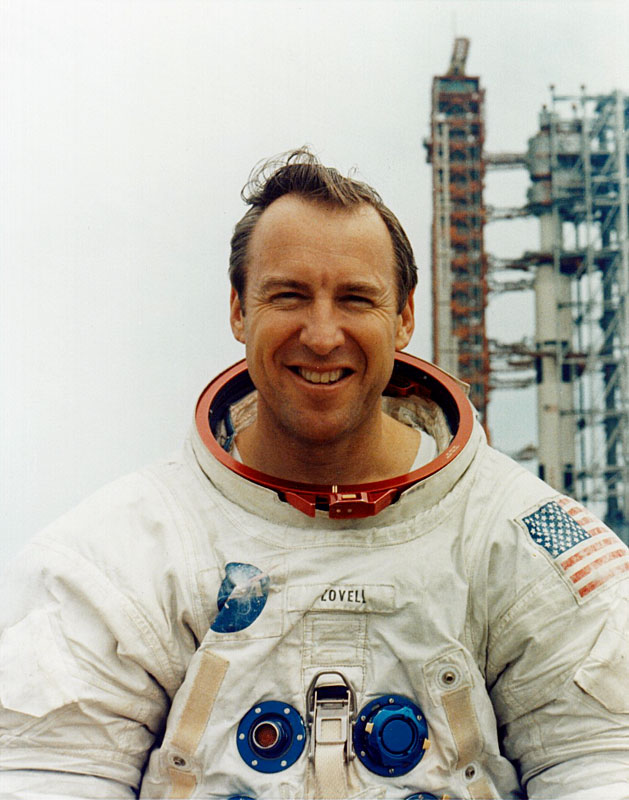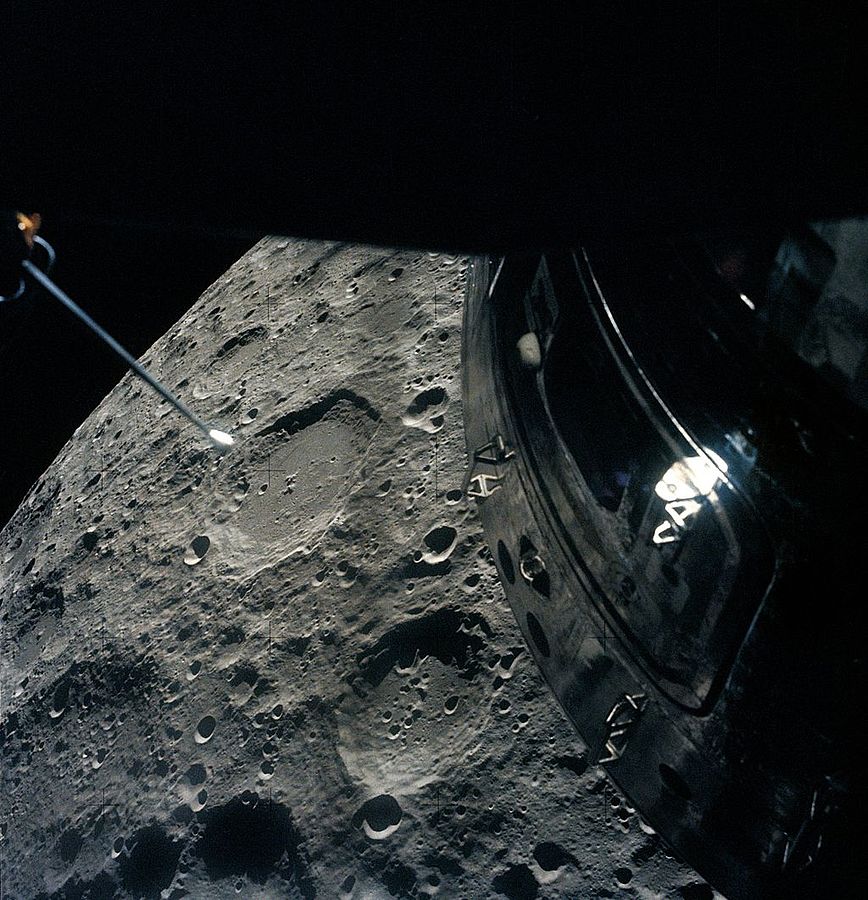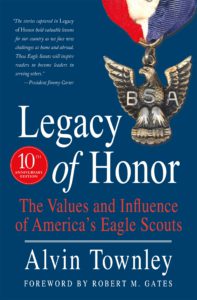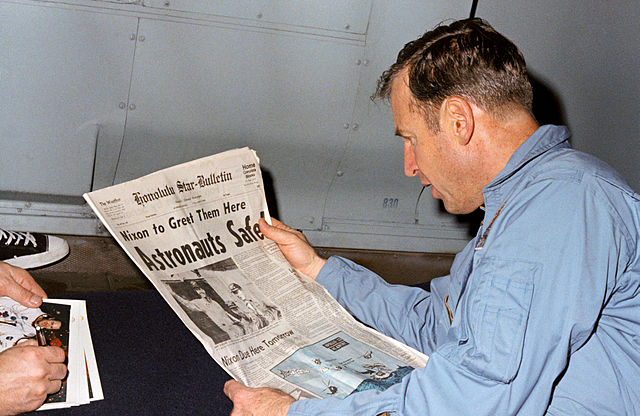by Alvin Townley
Jim Lovell: Troop 60, Milwaukee, Wisconsin
Jim Lovell later described the event as a “bang-whump-shudder,” and its reverberations pulsed through the spacecraft, knocking the astronauts into the walls of the cramped ship. Lovell, the mission commander, looked wildly to his crew. He hoped to meet a calm pair of eyes. He hoped Fred Haise or Jack Swigert knew what had happened. When their eyes met Lovell’s, they reflected the same bewilderment. A warning light illuminated. One claxon sounded, then others. More warning lamps began lighting the interior of Apollo 13’s command module.

“Houston, we’ve had a problem,” Lovell called to NASA Mission Control in Houston, 200,000 miles away. His words hung ominously in the air.
Simultaneously, flight directors in Texas and astronauts in space began to gather the scope of Apollo 13’s problem. Instruments showed that two fuel cells had disappeared, along with a tank that held half the ship’s oxygen. Pressure in the second oxygen tank nose-dived. A main section of the electrical system crashed; communication systems failed; the computer restarted. Technical glitches, in turn, created thruster problems, and soon short bursts from the small maneuvering jets began jolting Apollo 13 from port to starboard, pitching it forward and back. To the astronauts, it seemed in some ways terrifying, in other ways unreal.
“We could have panicked and bounced off the walls for ten minutes,” Jim Lovell later explained, “but then we’d be right back where we started. As long as it wasn’t a catastrophic situation like Columbia or Challenger, but one where we were still breathing and the spacecraft was not violated by a meteor, we just had to think. You had to be objective and positive in your thinking, not looking at your hands wishing for some miracle to happen. If we’d all gotten in a fetal position to wait for a miracle, we’d still be up there.”
The crew stayed calm, matter-of-factly reporting the situation to Houston and quietly following the returning instructions. Then Jim Lovell, for a reason he can’t recall, looked outside. He realized how serious his problem had become. “It looks to me that we are venting something,” he told Houston. “We are venting something into space.” These words hung in the air even more heavily than had his original announcement of the ship’s situation. Any hopes that Apollo 13 had just experienced a severe instrumentation problem vanished. An explosion, a meteor, something had damaged the ship. Gas, likely precious oxygen, continued seeping into the vacuum outside.
Everyone on the ground and aboard 13 realized they had to stop the venting. The ground crew eliminated each option they considered, then arrived at the last resort: shutting down the valves to the fuel cells. With the sealing of these valves, all chances of a lunar landing evaporated. When the order came through Jim Lovell’s headset, he realized their goal was not to salvage the lunar landing on Fra Mauro; their new goal was just surviving.
When oxygen tank two exploded on April 13,1970, at 9:07 in the evening, the Apollo 13 spaceship was really two craft linked together: the cone-shaped command module Odyssey, with its attached cylindrical shaft of engines, fuel, and oxygen, and the spidery lunar module Aquarius. The initial explosion had stricken computer and life-support systems aboard Odyssey, and less than two hours after the first shudder of trouble, the crew abandoned the dying command module. Aquarius, a craft designed to sustain two men for forty-five hours, became a lifeboat that would have to support three men for nearly ninety hours.
They had minutes to transfer precious navigation data from Odyssey’s computers to those in Aquarius. If they lost or misentered the data, navigating through space would become nearly impossible. In 1970, even NASA’s newest ships had no direct data links, so Jim Lovell figured transfer calculations with his pencil and paper, and he did so before time ran out.
Meanwhile, to recover the astronauts, Mission Control decided to alter i3’s course and sling-shot the ship around the moon on a trajectory that would let gravity, not engine power, send the ship directly back to earth. A naval aviator and veteran of Gemini 7, Gemini 12, and Apollo 8, Jim Lovell ranked among NASA’s finest pilots, but he had never flown a craft as unwieldy as Aquarius. Despite Odyssey’s 60,000 pounds of dead-weight, Lovell positioned his ship perfectly for an engine burn that placed him on the course home. Their odds began to improve, but on earth, they still remained long shots.
On board, Commander Jim Lovell quietly reviewed the odds himself. “As long as we were still breathing,” he said, “we were going to go as long as possible. If you want to put it in percentages, there was a ten percent chance we’d make it home again when the tank exploded. As we solved one problem after another, the percentages went up until at splashdown it became a hundred percent again.”
From their position 200,000 miles away, they still remained—literally and figuratively—dishearteningly far from splashdown. Once they swung around the moon, the crew pointed their ship toward home and burned the engine to build speed and shorten their return time. When the engine stopped, the crew powered down Aquarius to conserve the scant battery power that remained on board. Until they approached Earth several days later, Apollo 13 reportedly used as much electricity as a coffeemaker. Cabin temperatures dropped to 34 degrees, and the crew could barely sleep. Two essentially dead ships and three cold, tired astronauts hurtled across empty space toward Earth, covering thousands of meters per second.
Just when they had overcome their first slew of obstacles, another appeared: carbon dioxide. With every breath the astronauts exhaled, they added carbon dioxide to the cabin. The lithium hydroxide devices that removed the toxic gas from the atmosphere in Aquarius became saturated, but the similar devices in Odyssey would not fit into the environmental systems of the lunar module. Working with a team on the ground, the crew overcame this hurdle as well by hobbling together a contraption of paper, plastic, tape, and cardboard that scrubbed the air. They had solved another problem. But as they had almost come to expect, another issue arose shortly thereafter.

To reenter the earth’s atmosphere safely, Apollo 13 had to fall into a narrow wedge two degrees wide. Any shallower, and they would skip off the atmosphere like a flat stone off a lake and enter a permanent solar orbit. Any steeper, and the atmosphere would incinerate them. As it was, they were approaching too shallow. They needed to burn the engine again and correct their course, but the dire power shortage barred them from using computer guidance. Jim Lovell again took the controls and manually flew his ship. With the Earth’s terminator (the line between night and day) as his guide, he used his eyes and instincts to deepen 13’s approach. The crew cleared one more obstacle, but two more remained.
First, they had to restore power to the command module, their vehicle for reentry. With procedures developed by a team of exhausted NASA technicians, they returned Odyssey to life and jettisoned the service module that carried the ruptured tanks of fuel and oxygen. As the module floated gently away into space, it rolled slowly to show the crew the tangle of twisted metal left by the explosion of oxygen tank two. The astronauts could hardly believe the severity of the damage, and they began to worry that the explosion had cracked the adjoining heat shield. If the shield had sustained damage, the craft and crew would melt as they reentered the earth’s atmosphere. About that, however, they could do absolutely nothing except wait and see. NASA also knew Apollo 13 had again drifted dangerously near the shallow end of the reentry corridor. Neither the staff in Houston nor the astronauts aboard 13 could fix the situation, so Houston remained silent on the matter. Again, they would wait and see.

At 11:53 a.m. on Friday, April 17, 1970, Apollo 13 crossed into the earth’s atmosphere, and for the fourth and final time, Jim Lovell watched flames lap at the windows of a reentering spacecraft. The intense heat and ionization blacked out communications, and the entire world stood before television screens waiting for word. The typical three -minute blackout period passed with no contact. An agonizing minute after they had expected to hear from the crew, millions of people finally heard Jack Swigert’s voice announce their safe return. Under a canopy of parachutes, Apollo 13 settled onto the waves of the Pacific Ocean.
From Mission Control: “Odyssey, Houston. Welcome home. We’re glad to see you.”
“That old Scout motto, ‘Be Prepared,’ was very apropos in my situation,” a retired Captain Jim Lovell mused years later. “Being prepared means being knowledgeable about what you’re working with and what you’re doing, what the odds are, and how you can get out of certain situations. For instance, we never trained for more than single-point failures in the space program because if we trained for every possible failure that could go wrong, we’d still be down there waiting for the first takeoff.”
Apollo 13 suffered a triple -point failure, something NASA never truly considered since the chances were just too remote. Nobody ever devised ways for astronauts to address simultaneous electrical, fuel, and oxygen problems. If that much were to malfunction in space, the engineers assumed the ship would be lost. But, thankfully, crews in space and in Houston understood ingenuity and teamwork.
“You’ve got to rely on other people, especially in a space activity,” explained Jim Lovell. “You gotta trust each other to do the right thing, push the right buttons. You had to have trust that the control team in Houston knew what they were doing and wouldn’t get you in trouble!”
His modesty aside, teamwork by itself could not have brought Apollo 13 home. Ultimately, only three men could ensure the safe return of the ship, and these three men were roughly 250,000 miles away from Earth at their farthest. The decisions they made and the actions they took on board Aquarius and Odyssey would lead to the mission’s success, if only relative, or to tragic failure.
As he recounted his story in his Illinois restaurant, where the magnificent mural Steeds of Apollo reminds guests of the owner’s accomplishments, I found myself terribly preoccupied with how I might have handled the situation had I been inside Odyssey alongside a young Jim Lovell. The crew existed in two tiny, fluorescent-lit metal bubbles of light and oxygen. These bubbles were hurtling freely through the vacuum of space, days away from home, with only unreliable systems to return them there. I couldn’t imagine the fear and the pressure that must have permeated the atmosphere of the spacecraft. Yet the crew managed one emergency after another and got their ship and themselves back to Earth. Could I have stayed as focused as they did?
Now firmly back on Earth for more than three decades, Jim Lovell traced his ability to handle the situation to his days in Troop 60. He recalled summer camporees at Indian Mound Scout Reservation in Wisconsin, where he served as a counselor for several years. His Scoutmaster placed him in charge of a group of Scouts and tasked him with assembling the boys, pitching tents, cooking, and generally running the group. The Scoutmaster left Jim Lovell to succeed or fail on his own. He quickly learned about self-sufficiency.
“I learned to work on my own,” Lovell said, “to develop, hopefully, some leadership qualities: learning to work together to get things done better, using your imagination in getting things done. This is the thing Scouting does for you. It gets you away from your family. It makes you think for yourself.”
Now that our conversation had arrived back at Scouting, we mused together about the 180 Scouts who have served in the astronaut corps, including 40 Eagles. “There’s a lot of commonality between Scouting, astronauts, and spaceflight,” observed the veteran astronaut and past president of the National Eagle Scout Association. “That’s why a lot of Scouts gyrate in that direction. I think that Scouting is also the pursuit of exploration. Scouts are people who want to see things, who are curious, who are always wanting to look over the next horizon. That’s why they go to camp; to learn things, to go hiking, and to be active. This is [sic] the same criteria, the same elements that make up astronauts. They sort of live on the edge. They are very curious, they want to explore.”

“They also want to accomplish things,” he said of both breeds. “You work by objective. You’re not a nine-to-five kind of guy. You’re not a guy who just puts in hours to do a job to get a paycheck. You usually want to do things to see things happen. You want to have a sense of satisfaction, a sense of accomplishment in whatever you do, whether you’re going to the moon, going around the earth, going to the space station, or getting your Eagle badge.
“You learned to continue to go, not to give up too early,” he added. “Earning a merit badge, you could say, ‘Oh, I’ll wait until later; but I kept going. When I applied to the Naval Academy, I didn’t make it the first time, and I had to apply a second time. When I got into the space program, I didn’t make it the first time with the Mercury program. I applied again and got into the Gemini program. Perseverance also helped me after I got into these programs and was very important to me.” Every day, his wife Marilyn is thankful her husband always kept going during those cold, sleepless hours aboard Apollo 13.
As we closed our conversation, Jim Lovell shared one more Scouting memory with me. His cousin, Bill Leedy, had originally inspired Jim to join Scouting, and Lovell’s parents had sent their young Tenderfoot Scout into Bill’s care at Camp Krietenstein in Indiana. When he arrived at Krietenstein, Jim dragged his duffle bag into the cabin where Bill served as counselor. “On the first day, no sooner had I walked out the cabin’s front door than I tripped and broke my arm and was back in town,” Lovell remembered. “On the first day of camp life I was back in town getting my arm set with my mother worried and my cousin in deep trouble. But it turned out that it was a lesson that things don’t always go right. I’ve certainly learned that one over the years!”
When Apollo 13 splashed down, Jim Lovell became the world’s most famous astronaut. He had already spent more days in space than any other American and as navigator of Apollo 8, became one of the first men to orbit the moon, a feat that earned his crew the honor of Time magazines’s Men of the Year. Then he ended his career with Apollo 13. Although he never set foot on the moon—still a deep regret of his—his notoriety has probably lived much longer as a result of Apollo 13’s shortcoming. In a way, it was sad to see one of NASA’s greatest astronauts end his career with an incomplete mission. I soon discovered that with the perspective of time passed, Lovell views Apollo 13 as a failure from a mission standpoint but as a tremendous success from another. “Thirteen was an outstanding success in the way people reacted to a crisis and the leadership that was shown and the initiative that was produced,” he said. “It was a triumph in that area. So I have a different feeling about it now. I couldn’t think of a better thing to come through to show what we can do if we put our minds to it.”
Alvin Townley spent a year traveling throughout the country to explore the legacy of America’s Eagle Scouts. In thousands of miles of travel, he met with Eagles from all walks of life. The result was Legacy of Honor, a uniquely powerful narrative of character and virtue in American life.
Alvin’s journey truly began years ago in Atlanta, Georgia, where he followed the Scouting path of his grandfather and father and earned his Eagle Scout rank with Troop 103. He is a Brotherhood Member of the Order of the Arrow and has completed High Adventure treks at the Florida Sea Base, the Northern Tier Canoe Bases, and Philmont Scout Ranch.
The author graduated from Washington and Lee University in Lexington, Virginia. He has interned in the U.S. House of Representatives, served on the executive staff of an international consulting firm, and worked for his alma mater, where he built relationships with alumni across the country and spoke to classes on corporate strategy and ethics. Alvin currently resides in Atlanta, Georgia, where he works and coaches at Marist School. He also works with Reach for Excellence, a tuition-free program benefiting talented middle school students from under-served communities.
